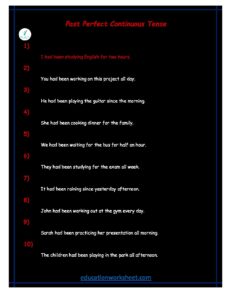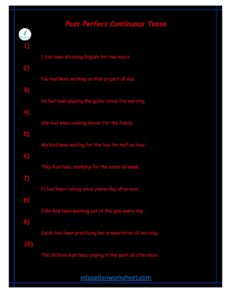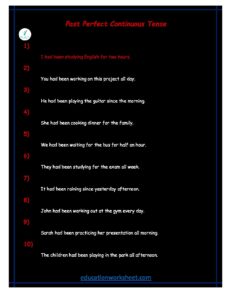how to converting Past Continuous Tense positive sentences to interrogative form
how to converting Past Continuous Tense positive sentences to interrogative form
The Past Continuous Tense is a verb tense used to describe actions that were ongoing or in progress in the past. When we want to change a positive sentence in the Past Continuous Tense into an interrogative sentence, we need to restructure the sentence to form a question. Here’s a detailed description of how to do that, step by step.
Identify the Past Continuous Tense Sentence:

Start with a positive sentence in the Past Continuous Tense. For example:
-
- “She was singing a song.”
Determine the Appropriate Question Word:
- “She was singing a song.”

- You need to choose the appropriate question word (also known as a question tag) based on the sentence’s context. Common question words include:
- Who: used to ask about the subject performing the action.
- What: used to ask about the action or activity itself.
- Where: used to ask about the location of the action.
- When: used to ask about the time of the action.
- Why: used to ask about the reason for the action.
- How: used to ask about the manner in which the action was performed.Begin the Question: Start the interrogative sentence with the appropriate question word. For our example sentence, let’s use “What”:
- “What was she…”Invert the Subject and Auxiliary Verb: In English interrogative sentences, we invert the subject and the auxiliary verb. In the Past Continuous Tense, the auxiliary verb is “was,” so it becomes:
- “What was she…”Move the Main Verb to the End: Move the main verb (in its base form, without “ing”) to the end of the sentence. In our example sentence, the main verb is “singing”:
- “What was she singing…”Complete the Question: To make it a complete interrogative sentence, add a question mark at the end:
- “What was she singing?”
- “What was she singing…”Complete the Question: To make it a complete interrogative sentence, add a question mark at the end:
- “What was she…”Move the Main Verb to the End: Move the main verb (in its base form, without “ing”) to the end of the sentence. In our example sentence, the main verb is “singing”:
- “What was she…”Invert the Subject and Auxiliary Verb: In English interrogative sentences, we invert the subject and the auxiliary verb. In the Past Continuous Tense, the auxiliary verb is “was,” so it becomes:
- You need to choose the appropriate question word (also known as a question tag) based on the sentence’s context. Common question words include:
how to converting Past Continuous Tense positive sentences to interrogative form

So, the original positive sentence “She was singing a song” becomes the interrogative question “What was she singing?” In this way, you can convert any positive sentence in the Past Continuous Tense to an interrogative form by following these steps.

